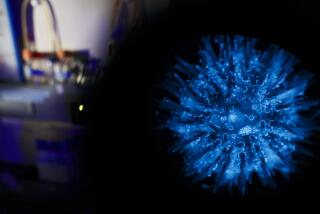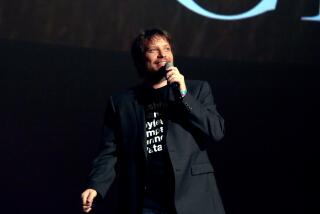Who needs film when you can store a movie in bacteria DNA?

Electroporation causes pores in bacteria’s membrane to open, allowing the synthesized DNA to pass into them. (July 13, 2017)
- Share via
You might call it the smallest movie ever made.
This week, a team of scientists report that they have successfully embedded a short film into the DNA of living bacteria cells.
The mini-movie, really a GIF, is a five-frame animation of a galloping thoroughbred mare named Annie G. The images were taken by the pioneering photographer Eadweard Muybridge in the late 1800s for his photo series titled “Human and Animal Locomotion.”
“The horse was one of the first examples of a moving image and very recognizable,” said Seth Shipman, a postdoctoral fellow in genetics at Harvard Medical School who led the work. “We liked that about it, but we didn’t spend a ton of time thinking about it. We weren’t sure how the research would go.”
Scientists had already shown that a great deal of information can be encoded and stored in synthesized DNA. For example, Shipman’s boss, George Church, a molecular chemist and engineer at Harvard, once converted an entire book into a strand of genetic code.
“DNA has a lot of properties that are good for archival storage,” Shipman said. “It’s much more stable than silicon memory if you wanted to hold something for thousands of years.”
In the new study, published Wednesday in the journal Nature, Shipman wanted to see if bacterial DNA could record the order in which new information was added to its genome.
“Last year we reported some success encoding a handful of sequences and getting some time information back from it,” he said. “But this time we decided to encode real information rather than arbitrary sequences.”
Coding five frames of a movie seemed a perfect place to start.
The researchers began by breaking each frame of the film into a grid of 36 pixels by 26 pixels. Next they developed a way to code the color of each pixel using the nucleotides A, C, T and G, which are the building blocks of DNA. They also included a code that indicated where in the frame each pixel belonged. They did not encode the order of the frames, however.
“That was important to us,” Shipman said. “We wanted to see if when the bacterial DNA captures the new information, it captures it in order.”
In the end, each frame consisted of 104 DNA sequences that the team inserted into a population of bacteria cells using a process called electroporation. Basically, they zapped the cells with electricity, which caused pores in their membrane to open, allowing the synthesized DNA to pass into them.
Once the DNA pieces were in the cells, the researchers relied on the gene editing system known as CRISPR to grab the free-floating pixel codes and insert them into the bacteria’s genome.
Using this process, Shipman and his colleagues “uploaded” their movie into the bacteria’s DNA at a rate of one frame each day.
After the entire movie had been inserted into the genome, the authors boiled the cells to extract the DNA and then sequenced the regions where they thought the encoded movie frames would be. They ran the extracted sequences through a computer program and found they were able to play back their movie with 90% accuracy.
It turns out that the bacteria’s DNA conveniently stores new information in the order it is received, Shipman said.
He added that when the group uploaded the movie backward and then extracted it, they were able to watch the horse run in reverse.
“It’s a very cool paper,” said Jay Shendure, a geneticist at the University of Washington who was not involved with the work.
He said one of the most exciting aspects of the study is that the authors used the CRISPR-Cas system, which is indigenous to bacterial cells, to do some of the work.
”The GIF is encoded into the DNA sequence by humans,” Shendure said, “but those sequences are then processed, stored and replicated by living cells.”
The team also learned that tacking on a whole bunch of nucleotides to a strand of DNA does not appear to hurt a cell. They let the bacteria with the additional DNA sequences grow for a week in solution, and found they reproduced at the normal rate.
“If there was a fitness cost, you would imagine the information would be lost over time, but it doesn’t seem to cost the cell anything to have it,” he said.
Encoding a short movie into cellular DNA is a neat trick, but Shipman said the work only represents a stepping stone toward a bigger goal — building tiny biological recorders that can capture and store what is going on in a cell or in its environment.
For example, Shipman is interested in learning what causes developing brain cells, which all look the same, to mature into one type of neuron or another.
“There are certain places we can’t go that a cell can go,” Shipman said. “The brain is locked away inside the skull, and these changes happen rapidly and all at the same time.”
Eventually he hopes to create a way for individual cells to record the molecular steps that tell them what type of neuron to become. He noted that other researchers in Church’s lab are building sensors that could collect that information.
“Getting back information we already knew is great,” he said. “But we eventually want to get back information we didn’t know.”
Michael Elowitz, a professor of bioengineering at Caltech, said the study represents a significant step toward that goal.
“This is beautiful work that advances the dream of being able to turn cells into virtual recording systems,” he said. “The recording of a movie demonstrates in an incredibly clear and direct way just how versatile this information storage system can be.”
Do you love science? I do! Follow me @DeborahNetburn and “like” Los Angeles Times Science & Health on Facebook.
MORE IN SCIENCE
To combat teen smoking, health experts recommend R ratings for movies that depict tobacco use
Two big studies bolster the claim that coffee – even decaf – is good for you
Policy change in Jakarta accidentally teaches drivers the value of carpool lanes
UPDATES:
12:30 p.m. July 13: This story has been updated to include comments from University of Washington geneticist Jay Shendure and Caltech bioengineeer Michael Elowitz.
This story was originally published at 11 a.m. on July 12.







